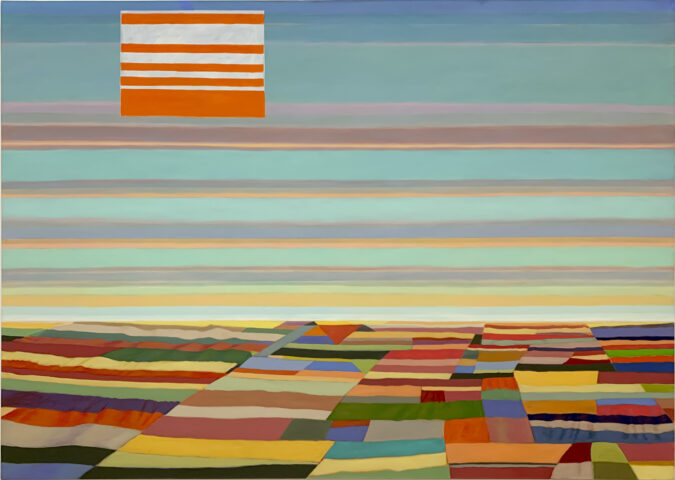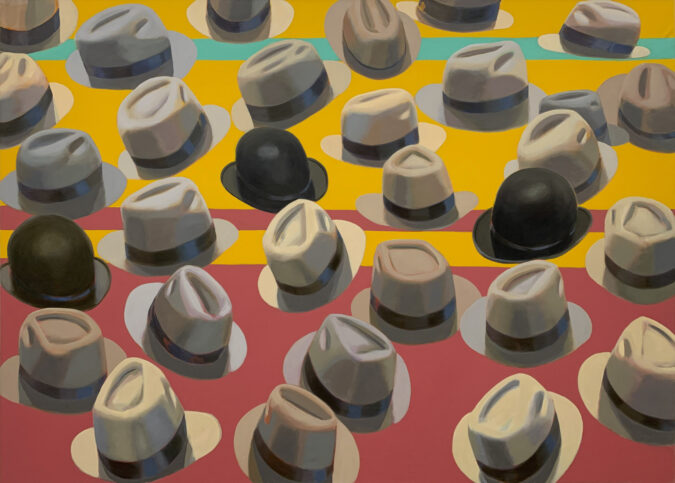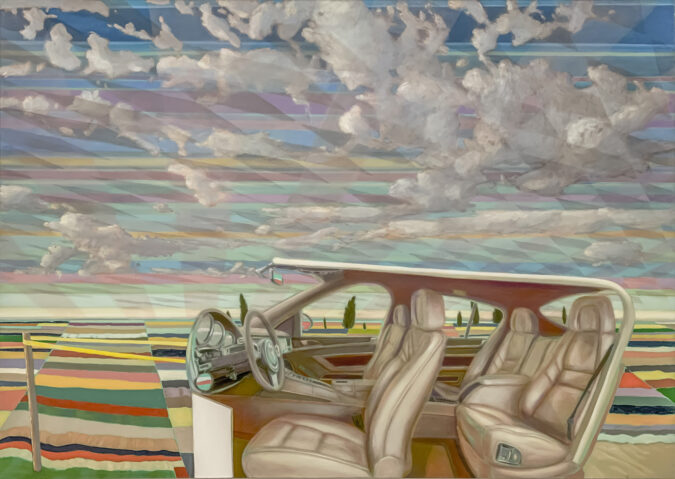Greg Drasler
Metaphorical depictions of construction sites and workers have inspired Greg Drasler’s paintings since the early 1980s. Accumulations of tools and objects populated his paintings, addressing the construction of identity. Crowds of men in hats along with the baggage paintings contained humor, nostalgia, and memory in ongoing assemblies of selves. Drasler describes his painting process as packing and re-packing an empty suitcase or painting the inside out.
Drasler’s current work, Road House Project, continues the use of assembly procedures in constructing patterned panoramas. His current exhibition Crowded Places / Open Spaces is at the Betty Cuningham Gallery, NYC. Through March 20, 2021. It includes Road House paintings, Hats Painting and a series titled Bus Stops and Checkpoints.
Drasler is the recipient of a National Endowment Grant, a NYFA grant, a Guggenheim Fellowship and a Pollock Krasner Fellowship. Read more about his work at Art Spiel.
Question:
Pattern is often used in visual art but you use pattern in a distinct way, finding pattern among everyday objects and places which are not explicitly patterned. There is an odd connection between apophenia, a potentially pathological “tendency to perceive meaningful connections between seemingly unrelated things” and the receptive frame of mind of the artist when making art. Where does your use of repetition and visual rhyming come from? Are they a discovery or imposition? Repetition can highlight the significance of the motif, conversely it can encourage the meaning of the motif to disintegrate, like repeating a word until it becomes strange in your mouth and mind. Is the evaporation of meaning, caused by patterning, important to you?
Answer:
I am never shy of a pathological tendency. I paint disconnected things making associations in inevitable patterns one thing after another. I began, 30 years ago, with a series of categorical subjects for paintings. Workers, hats, baggage, interiors, and landscapes have formed cumulative repetitions in kind in my paintings. Contrary to meaninglessness through repetition, I find an expansion of variables and effects open for my consideration through repetition.
My apophenia cannot be denied.
The procedure of painting patterns, one stroke after another, has a surveyor’s orientation. Patterns hold my activity in a state of openness. In picturing the web, the net, or cloud computing, I use patterns to give dimension to atmospheres.
Initially, I did not relate the pattern to the composition of Hats Paintings. I began these as a series 30 years ago. They have become an organic pattern. Insinuating a pattern in a canvas’s cramped space suggests questions about what this crowd is doing. When it comes to building a crowd, the concentration and individual shrugs and nods express an organic collection of patterns of readability.
In the Road House paintings, I use patterns in a perspectival form to tie the atmosphere back to the horizon and suggest endlessness or the grip of perspective. The picturing of cloud computing is of one pattern meeting another, indicating differences in atmospheres. The repeated frame-by-frame construction of the landscape paintings lends a cinematic effect in one frame at a time.
As pattern recognition is hard-wired to predict what is next. I have been using patterns as a predictive reach. I also rely on patterns to provide a sense of context, location, and orientation as a sense of place. I have used patterns for various effects, from the surveyors’ plumb line grid to figured extravaganzas. Patterns are things.









I find Greg’s “Trojan Horse” a captivating painting.
Patterns are not the theme as much as the juxtapositions.
L.
Thanks Lucio. I’m glad you like it.
Best,
Greg
A really cogent description of the work. I would add that I personally find the disruption of the patterns to be of equal interest: the suggestion of another space and time in the square at the top left of “Rear View’, as well as the disjunctive patterns of travel over time through space in the very long paintings.
Hi Greg, such high standards in your work as always. The colors in Trojan House (typo or intentional?) are incredible, the patterning complex and commanding. Just stunning!
Best to you,
Elizabeth
Oh and the Renaissance trees through the car window… a treat!
Maybe not a narritive nor a abstractionist art but rather symbols as sound effects = u make some wonderful music Greg.